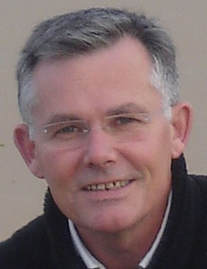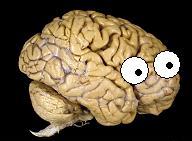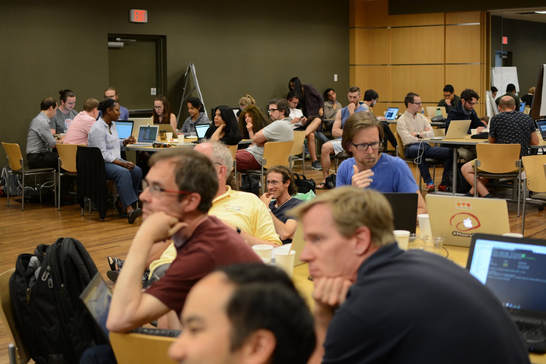|
By Shruti Vij
To advance human brain mapping we need to develop and identify novel facets of brain function, and understand how they are affected in clinical disorders. Like any other field, we rely on young investigators to bring innovation and creativity. And when we find stellar individuals that contribute towards the advancement of the entire field, we reward them, with a Young Investigator Award! This year’s OHBM Young Investigator award winner is one such impressive researcher with a reputation for making significant contributions to cognitive neuroscience – Lucina Uddin. Katherine Karlsgodt from UCLA who nominated her for the award introduces her as “a researcher with remarkable focus and productivity”, highlighting that:
1 Comment
Innovation doesn't come just from giving people incentives; it comes from creating environments where their ideas can connect. June 28th 2017, Vancouver, 4:30 am
Looking out the window in that predawn hour, it was like peering into the black box of time itself, a place where the past, present, and future come together. But as I watched, the sky played with at least a thousand permutations of midnight blue, before it burst into all hues of gold and red. It was at that moment that I thought to myself … “it’s gonna be a great ride today”. Because, not only was I launching the OHBM Student and Postdoctoral Special Interest Group’s inaugural Mentorship Symposium that afternoon, an initiative that I ardently hoped would continue in future years, but also would I be interviewing Marsel Mesulam, a founding member of OHBM and a longstanding academic inspiration of mine. June 28th 2017 was the day I was going to board the OHBM time machine to record an oral history of neuroimaging from one of the pioneers of the field, and gain his perspective on its future.  Bernard Mazoyer Bernard Mazoyer By Nils Muhlert Bernard Mazoyer, Professor of Radiology & Medical Imaging at Bordeaux University Hospital, has been at the forefront of the human brain mapping community for thirty years. In 1989, Bernard, Nathalie Tzourio-Mazoyer and Marc Joliot founded the functional imaging group (GIN-IRM), the first neuroimaging group in France. As a founder member of OHBM --- indeed, organising what was to become its first meeting in Paris --- Bernard has seen the organisation grow from hundreds of members to many thousands. Here we find out about his background, and his views on why OHBM may now be ready to become a society: by Agâh Karakuzu
The 5th OHBM Hackathon was an official component of the 23rd Annual Meeting of the OHBM held in Vancouver, June 25-30th 2017, with support from two leading open science institutions: the McGill Centre for Integrative Neuroscience, and the Stanford Center for Reproducible Neuroscience. Imagine entering a room full of people with flashy stickers on the back of their laptops. Gathering around tables, they stare at screens full of code, colorful text on a black background reminiscent of the code rain from the Matrix trilogy. Welcome to the control room of computational neuroscience! There is a reason why we call these neuroscientists ‘hackers’: they are hacking to provide their colleagues with accessible and powerful computational methods, or whatever means necessary, to crack the brain code.  BY RUSSELL POLDRACK, 2018 OHBM EDUCATION CHAIR The Educational Courses at OHBM are an essential part of the meeting for many attendees, and we are always looking for ways to make them more effective and engaging for a diverse group of participants. Educational courses are selected based on submitted proposals from the community, with submissions due on Dec 15. We desire a diverse set of presenters, and women and individuals from underrepresented groups are strongly encouraged to apply. Historically, educational courses have been composed of lectures along with some time for discussion. This year we would like to encourage proposers of educational courses to consider the adoption of active learning approaches in their proposals. Active learning means many different things to different people, but in general it refers to approaches in which the student takes an active role in the learning experience beyond simply absorbing information from the lecturer. A substantial body of research has shown that active learning approaches improve educational outcomes and student engagement (see for example this commentary by Carl Weiman). Additional information about these approaches can be found at the CSWEI and the University of Michigan. Q&A with Wouter BoekelBy Neuroskeptic & Chris Gorgolewski At the 2016 OHBM Annual Meeting, a new ‘Replication Award’ was announced that aimed to promote and reward reproducibility in neuroimaging research, and to open science more generally. Here, we hear from Neuroskeptic, a prominent blogger and advocate of open science, as to why replication studies are pivotal in improving the quality of our science. We then learn from this year’s recipient of the OHBM Replication Award, Wouter Boekel, about his winning study.  Neuroskeptic: I’m very pleased to have been invited to write a few words on why replication studies are important in science. Congratulations to Wouter Boekel for winning the Award (for a study which I blogged about at the time it was published). In my view, replicability is the essence of scientific truth. To say that a certain scientific result is true or valid, is nothing other than to say that someone, who correctly carries out the same methods, would be able to confirm it for themselves. Without the assumption of replicability, scientific papers would become merely historical documents – ‘we did so and so, and we observed so and so, but your mileage may vary. |
BLOG HOME
Archives
January 2024
|


 RSS Feed
RSS Feed